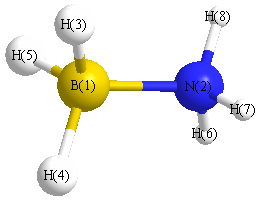|
|
II.B.6. |
Experimental Barriers to Internal Rotation for BH3NH3 (borane ammonia)
Data from:1983Tho/Sue:167
LR Thorne, RD Suenram, FJ Lovas "Microwave spectrumm, torsional barrier, and structure of BH3NH3" J. Chem. Phys. 1983, 78, 167-171
V3 = 2.008 kcal mol-1 (702 cm-1)
| torsion index | Angle | Energy (kJ mol-1) | Energy (cm-1) |
|---|---|---|---|
| 1 | 0 | 8.40 | 702 |
| 1 | 15 | 7.17 | 599 |
| 1 | 30 | 4.20 | 351 |
| 1 | 45 | 1.23 | 103 |
| 1 | 60 | 0.00 | 0 |
| 1 | 75 | 1.23 | 103 |
| 1 | 90 | 4.20 | 351 |
| 1 | 105 | 7.17 | 599 |
| 1 | 120 | 8.40 | 702 |
| 1 | 135 | 7.17 | 599 |
| 1 | 150 | 4.20 | 351 |
| 1 | 165 | 1.23 | 103 |
| 1 | 180 | 0.00 | 0 |
| 1 | 195 | 1.23 | 103 |
| 1 | 210 | 4.20 | 351 |
| 1 | 225 | 7.17 | 599 |
| 1 | 240 | 8.40 | 702 |
| 1 | 255 | 7.17 | 599 |
| 1 | 270 | 4.20 | 351 |
| 1 | 285 | 1.23 | 103 |
| 1 | 300 | 0.00 | 0 |
| 1 | 315 | 1.23 | 103 |
| 1 | 330 | 4.20 | 351 |
| 1 | 345 | 7.17 | 599 |
| 1 | 360 | 8.40 | 702 |
Atoms in torsion 1 are 3, 1, 2, 6
The rotor type is BH3

Got a better number? Please email us at
cccbdb@nist.gov